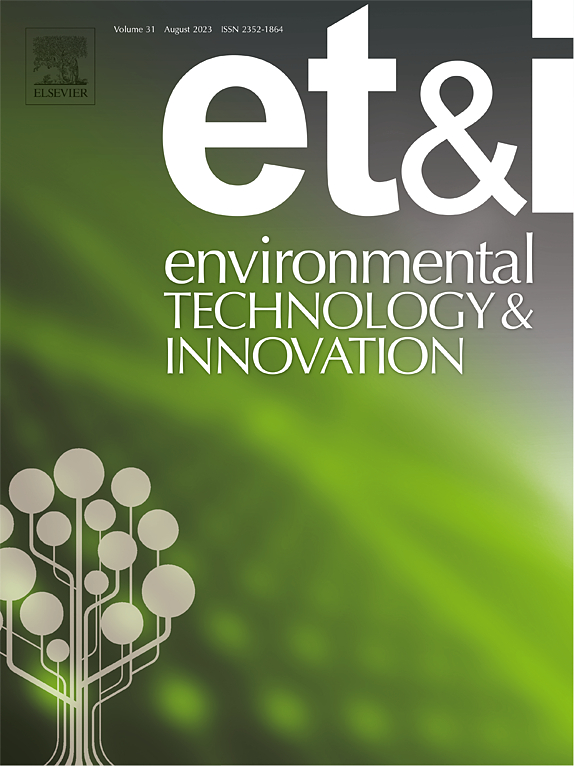甲烷厌氧氧化驱动的生物固氮支撑了冷渗生境中复杂的生物群落
IF 6.7
2区 环境科学与生态学
Q1 BIOTECHNOLOGY & APPLIED MICROBIOLOGY
引用次数: 0
摘要
冷渗代表了一类普遍存在于深海环境中的化学合成生态系统。尽管对冷渗漏的功能微生物学进行了广泛的研究,但在不同空间尺度的减少沉积物栖息地中,甲烷氧化如何与氮和硫循环耦合仍不清楚。本文采用宏基因组测序技术对海马冷渗沉积物中的微生物群落进行了研究,重点关注了不同空间尺度下参与生物地球化学循环的微生物。在规则沉积物区表层,硫氧化细菌如Chromatiates、PS1、SZUA-229和GCF-002020875是数量最多的类群。这些细菌回收硫化物并生成硫酸盐,同时促进硝酸盐的去除,以支持亚表层的甲烷厌氧氧化。而在冷渗生态系统的生物沉积物中,甲烷厌氧氧化和固氮是主要的过程。硫酸盐还原菌C00003060和ANME-1等微生物偶联群利用甲烷厌氧氧化产生的能量完成固氮。这些发现表明冷渗重氮营养体可以通过提供固定氮来支持复杂的生物群落。本研究增强了我们对冷渗生态系统中功能性微生物结构和代谢能力的理解。本文章由计算机程序翻译,如有差异,请以英文原文为准。
Biological nitrogen fixation driven by methane anaerobic oxidation supports the complex biological communities in cold-seep habitat
Cold seeps represent a class of chemosynthetic ecosystems that are prevalent in deep-sea environments. Despite extensive research on the functional microbiology of cold seeps, it remains unclear how methane oxidation is coupled with the nitrogen and sulfur cycles in the reduced sediment habitats across various spatial scales. Here, we employed metagenomic sequencing to investigate the microbial communities within the Haima cold seep sediments, with particular attention to microorganisms involved in biogeochemical cycles at varying spatial scales. In the surface layer of regular sediment areas, the sulfur-oxidizing bacteria such as Chromatiates, PS1, SZUA-229, and GCF-002020875 were the most numerically abundant groups. These bacteria recycle sulfide and generate sulfate while facilitating nitrate removal to support the methane anaerobic oxidation in the subsurface layer. However, in the biogenous sediments of cold seep ecosystems, methane anaerobic oxidation and nitrogen fixation emerge as the predominant processes. The microbial coupling groups, including sulfate reducing bacteria C00003060 and ANME-1, utilize energy from methane anaerobic oxidation to complete the nitrogen fixation. These findings suggest that cold-seep diazotrophs can support complex biological communities by supplying fixed nitrogen. This study enhances our understanding of the functional microbial structure and metabolic capabilities within cold seep ecosystems.
求助全文
通过发布文献求助,成功后即可免费获取论文全文。
去求助
来源期刊

Environmental Technology & Innovation
Environmental Science-General Environmental Science
CiteScore
14.00
自引率
4.20%
发文量
435
审稿时长
74 days
期刊介绍:
Environmental Technology & Innovation adopts a challenge-oriented approach to solutions by integrating natural sciences to promote a sustainable future. The journal aims to foster the creation and development of innovative products, technologies, and ideas that enhance the environment, with impacts across soil, air, water, and food in rural and urban areas.
As a platform for disseminating scientific evidence for environmental protection and sustainable development, the journal emphasizes fundamental science, methodologies, tools, techniques, and policy considerations. It emphasizes the importance of science and technology in environmental benefits, including smarter, cleaner technologies for environmental protection, more efficient resource processing methods, and the evidence supporting their effectiveness.
 求助内容:
求助内容: 应助结果提醒方式:
应助结果提醒方式:


